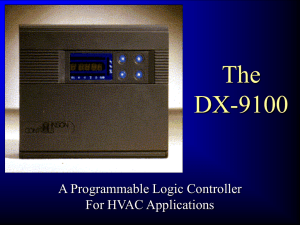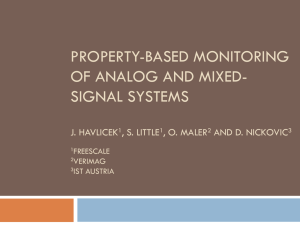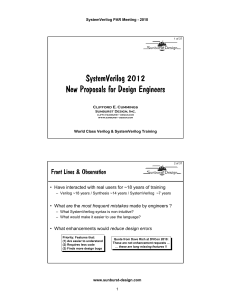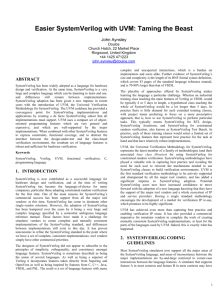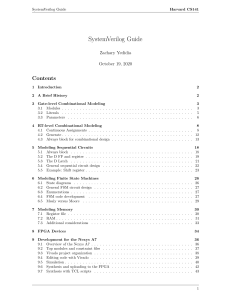ASVA-p1800
advertisement
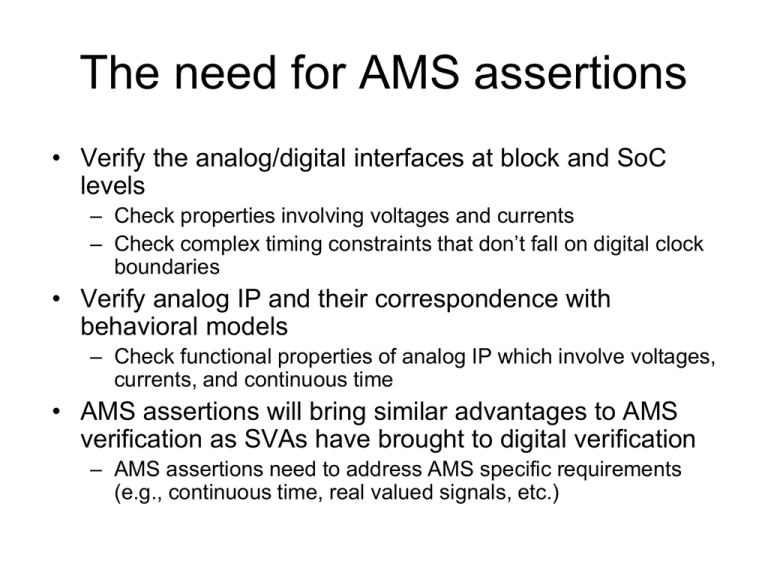
The need for AMS assertions • Verify the analog/digital interfaces at block and SoC levels – Check properties involving voltages and currents – Check complex timing constraints that don’t fall on digital clock boundaries • Verify analog IP and their correspondence with behavioral models – Check functional properties of analog IP which involve voltages, currents, and continuous time • AMS assertions will bring similar advantages to AMS verification as SVAs have brought to digital verification – AMS assertions need to address AMS specific requirements (e.g., continuous time, real valued signals, etc.) Examples of assertions • Comparison of voltage and current values: – If a is greater than 4.5 V then b and c differ by at most 0.1 V. • Timing checks: – The delay between the crossing of a at 2.5 V and the next crossing of b at 4.5 V is 250.0 ns with a tolerance of 2.5 ns. • Digital to analog interactions: – If a crosses 0.5 then b should rise followed by c rising 1 clock cycle later. ASVA committee vision and status • General vision for ASVA: – Extend SVA to continuous time while preserving the underlying digital semantics – Enable SVA expressions to reference real valued signals (e.g., voltages, currents) and events involving them – Enable assertions to observe relevant quantities from mixed models and eventually integrated SV-VAMS models – Understand performance/accuracy trade-offs for evaluating assertions with and without influencing the analog solver • Status – Requirements have been voted upon – Technical details of implementing the requirements are being investigated • Relationships with academic temporal logics and the implications for expressiveness and complexity are being considered (e.g., MITL, STL) What do we want from P1800? • Feedback from SV-AC (participation is welcome) • Assistance in implementing ASVA requirements, in particular those involving mixed model access, in a way that is harmonious with SV and its roadmap – A spectrum of solutions has been discussed – Feasibility of various solutions depends on the progress of the SV-VAMS integration – Preliminary and interim solutions can be improved with tighter and earlier integration Backup slides The Analog Engine (A first approximation) • An analog model is fundamentally a set of differential algebraic equations. – The solution is a function of time. • An analog engine calculates an approximation to the function at a sequence of discrete points in time – The calculation of each point is computationally costly • The analog engine itself chooses the times – The engine uses a variety of analytical and heuristic techniques to fine tune the trade-off between accuracy and performance by choosing the time step wisely. The Analog Engine (II) (The Truth) – That was an over simplification. In truth: • The user’s model divides time into intervals bounded by the zero crossings of some function of the solution • Freedom to choose is granted to the engine only in the interior of each interval – For a complete mixed-signal simulator • external events from a digital event-driven engine as well as zero crossings can determine the limits of intervals • The analog engine generates digital events synchronously at zero crossings – Now, that’s the truth! Assertion requirements • ASVA will include as a subset all productions of the SystemVerilog Assertion language (SVA). • The SVA subset of ASVA will have the same semantics as defined by SystemVerilog. • ASVA will support assertions that refer explicitly to the relative timing of events (temporal distance). • ASVA will support Boolean-valued relational operators on real-valued subexpressions. Synchronization requirements • The ability to force an analog solve point from within SystemVerilog. • Access to the double precision time value and analog quantities from the most recent analog solve point. • Ability to read Verilog-AMS quantities from SystemVerilog. The Verilog-AMS value that is read will be equivalent to the value that would be given to a digital request in Verilog-AMS. Mixed model access requirements en route to integrated SV-VAMS • Well-defined syntax and semantics for cross instantiation, including the SystemVerilog bind statement • Ability to instantiate a SystemVerilog module or checker within a Verilog-AMS context in a place where a Verilog-AMS module may be instantiated. Ability to bind a SystemVerilog module or checker to a Verilog-AMS target module or modules • Ability to access analog events within SystemVerilog • Ability to assign a real array to a wreal vector Mixed model access requirements en route to integrated SV-VAMS • Ability to make SystemVerilog/Verilog-AMS port connections between data types whose connection is legal within SystemVerilog, unless specifically prohibited prior to SV-VAMS integration – Connect a Verilog-AMS event expression to a checker port of type event – Connect a Verilog-AMS expression of an integral type to an assignment compatible port as specified in SystemVerilog – Connect a Verilog-AMS expression of a real or wreal type to a port of a SystemVerilog real type – Connect a Verilog-AMS expression of type array of real or array of wreal to a port whose type is an unpacked array of SystemVerilog real type





